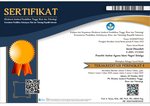Pemanfaatan Museum Sumpah Pemuda sebagai Sumber Belajar melalui Teknologi Virtual Reality
Abstract
This research aims to explore the utilization of the Youth Pledge Museum as a learning resource through Virtual Reality (VR) or Virtual Tour technology, and to understand the process of using VR in history education. The research adopts a qualitative method with a phenomenological approach. The focus of the study includes three main components: 1) Museum collections and their management, 2) The process of utilizing the Youth Pledge Museum collections as a source of historical learning through VR technology, and 3) The role of teachers in history education through VR technology. Data for the research were collected through observation, semi-structured interviews, and document analysis related to the Youth Pledge Museum and the use of VR in history education. This article describes the various collections held by the Youth Pledge Museum and the technologies that have been developed, including Virtual Reality (VR), which can be used in history education. The steps for using VR in history education include: 1) Selecting a relevant Virtual Reality museum for the learning material, 2) Preparing the necessary applications and equipment, 3) Setting up an Android phone, 4) Ensuring internet connectivity, 5) Finding the link to the Virtual Reality content of the Youth Pledge Museum, 6) Accessing the discovered link and starting the Virtual Tour. As a form of technology-integrated learning, the use of VR is expected to accommodate the development of 21st-century skills and encourage students to become active learners. This approach aligns with the student-centered learning concept applied in the independent curriculum, allowing students to construct their own knowledge.
Keywords: museums, youth pledges, learning resources, Virtual Reality.
Keywords
Full Text:
PDFReferences
Alsa, A. (2011). Pendekatan kuantitatif dan kualitatif serta kombinasinya dalam pe- nelitian psikologi. Yogyakarta: Pustaka Pelajar.
Ariatama, S., Adha, M. M., Rohman, R., Hartino, A. T., & Eska, P. U. (2021). Penggunaan Teknologi Virtual Reality (Vr) Sebagai Upaya Eskalasi Minat Dan Optimalisasi Dalam Proses Pembelajaran Secara Online Dimasa Pandemik. In Semnas FKIP 2021, SEMINAR NASIONAL PENDIDIKAN FAKULTAS KEGURUAN DAN ILMU PENDIDIKAN, Universitas Lampung16 Februari 2021, Bandar Lampung..
Creswell, J. (2008). Educational Research. Planning, conducting, and evaluating quantitative and qualitative research. PearsonPrentice Hall.
Evitasari, O., Qodariah, L., & Gunawan, R. (2020).Pemanfaatan Fungsi Museum Sebagai Sumber Belajar Sejarah Dalam Mengembangkan Kemampuan Berpikir Kritis. Estoria: Journal of Social Science and Humanities, 1(1), 43-56.
Jamil, M. (2018). Pemanfaatan Teknologi Virtual Reality (VR) di Perpustakaan. Buletin Perpustakaan Universitas Islam Indonesia, 1(1), 99-113.
Jubaedi, A. D., & Dwiyatno, S. (2020). Implementasi Teknologi Virtual tour pada Museum. JSiI (Jurnal Sistem Informasi), 7(2), 70-77.
Pamungkas, S. B. (2014). Ganti Rezim Ganti Sistim-Pergulatan Menguasai Nusantara. Sri-Bintang Pamungkas.
Pribadi, B. A. (2017). Media & teknologi dalam pembelajaran. Prenada Media.
Raco, M. E. (2010). Metode penelltlan kualltatlf jenis, karakteristik, dan keunggulannya.
Riyadi, F. S., Sumarudin, A., & Bunga, M. S. (2017). Aplikasi 3d virtual reality sebagai media pengenalan kampus politeknik negeri indramayu berbasis mobile. JIKO (Jurnal Informatika dan Komputer), 2(2), 75-82.
Roosandriantini, J. (2020). akulturasi Arsitektur rumah adat kebaya pada museum sumpah pemuda. jurnal malige, 2(2), 44-49.
Saurik, H. T. T., Purwanto, D. D., & Hadikusuma, J. I. (2019). Teknologi Virtual Reality untuk Media Informasi Kampus. J. Teknol. Inf. dan Ilmu Komput, 6(1), 71.
Septikasari, R., & Frasandy, R. N. (2018). Keterampilan 4C abad 21 dalam pembelajaran pendidikan dasar. Tarbiyah Al-Awlad: Jurnal Kependidikan Islam Tingkat Dasar, 8(2), 107-117.
Sulistriani, S., Santoso, J., & Oktaviani, S. (2021). Peran Guru Sebagai Fasilitator Dalam Pembelajaran IPA Di Sekolah Dasar. Journal Of Elementary School Education (JOuESE), 1(2), 57-68.
Sugiyono. (2018). Metode Penelitian Kuantitatif Kualitatif dan R & D (2nd ed.). CV Alfabeta.
DOI: https://doi.org/10.18326/dinamika.v4i1.13-32
Refbacks
- There are currently no refbacks.
Copyright (c) 2023 Muhammad Afif Maghfur

This work is licensed under a Creative Commons Attribution-ShareAlike 4.0 International License.








